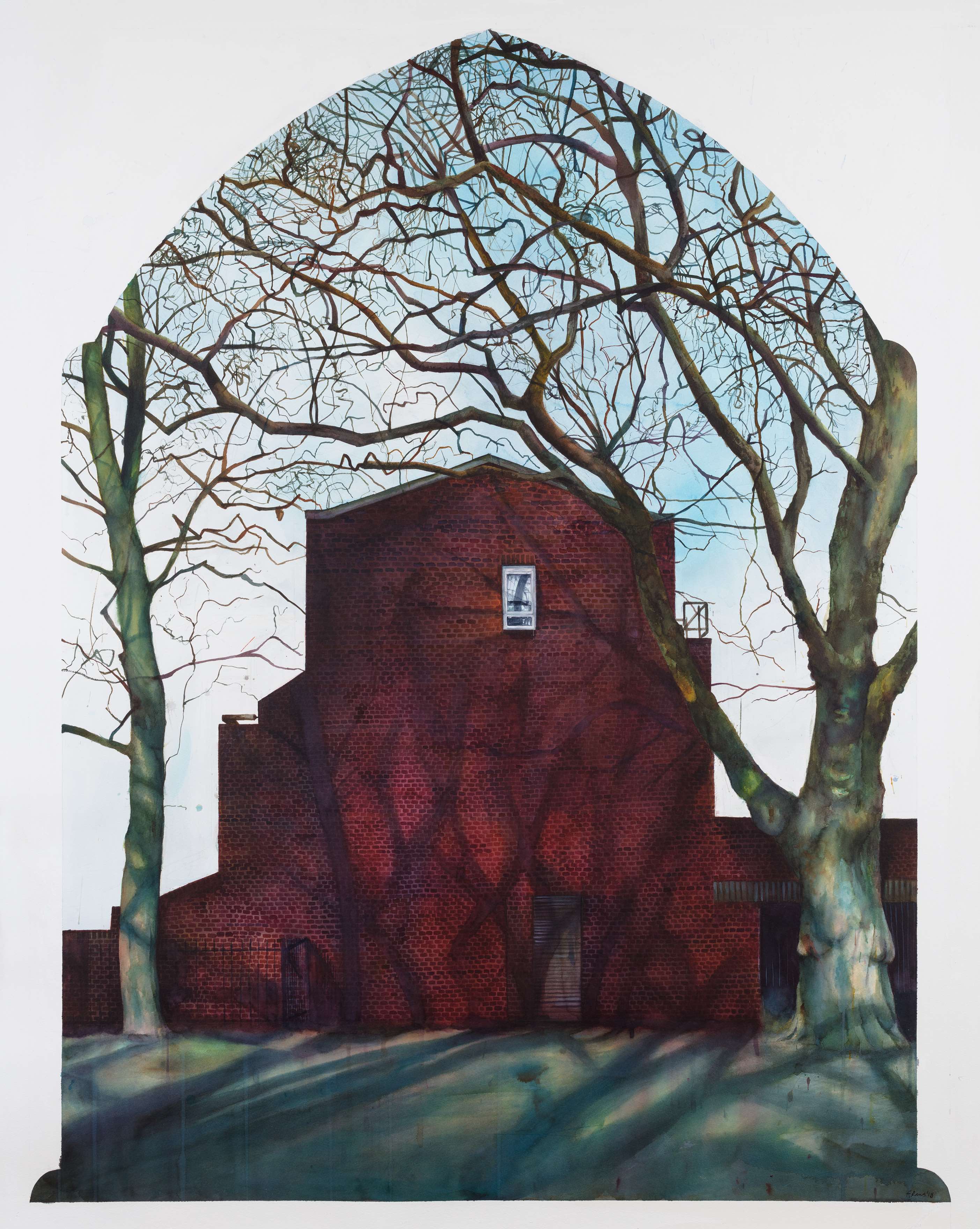A visual homage to the architecture of east London
- Text by Tom Usher
- Photography by Frank Laws

The word ‘Sonder’ – coined in 2012 by the Dictionary Of Obscure Sorrows – is the realisation that “each random passerby is living a life as vivid and complex as your own.”
It’s when meandering around London between midnight and dawn; when the light of the sunrise slowly breaks apart the obsidian into pieces of pink, lilac and indigo, that I often get struck by this feeling, especially when walking past people’s well-lit homes.
That same feeling is pronounced when looking at the work of artist Frank Laws, whose recent exhibition, Monuments, is a collection of paintings documenting the architecture of East London housing.
The paintings are watercolours that depict front doors, lamplit street corners and red-brick estate fronts. Places like Regents and Rhodes Estate, or Beckford House and Banister House, are bathed in evocative lighting that replicates the feeling of walking past them alone at dusk, dawn or night.
“When you look at these, you see homes,” Laws explains. “I don’t put any people in it, but the buildings end up telling you about the people, and become characters in themselves.”

MONUMENT VII

MONUMENT II
“There are loads of people that have told me that the pictures remind them of their own times in around their own homes, coming back from football, or ‘I grew up in a place like that’, or ‘this reminds me of my mum is shouting at me to come in at night.’”
As Brutalism and the architecture of post-war social housing become increasingly glorified in popular culture, it’s easy to forget that these buildings are, first and foremost, where people live. For example, when Robin Hood Gardens – an east London estate that was a perfect example of post-war social housing in the UK – was set to be demolished, there was outrage over a very real sense of loss both socially and architecturally.
It was labelled as an act of “vandalism” by Simon Smithson, the son of one of its original architects, and the V&A Museum even went to great lengths to salvage a three-storey section of it. At the time, they said that it wasn’t “just the object” that they wanted to preserve, but the issues around “social housing and urbanism”. Laws’ Monuments collection, albeit in a less literal way, has a similar aim of preservation.
“I wanted to highlight these very normal houses,” says Laws. “Robin Hood Gardens is a monument to the architecture of social housing, but this is more about giving everyday houses a monumental status.”
“My fantastical idea is that one day in the future these might become future relics. As an idealist, I’d like to think in 100 years time people might look at these paintings and be amazed at what East London used to look like.”

MONUMENT V

MONUMENT I

MONUMENT III

MONUMENT IV

MONUMENT VI
See more of Frank Laws work on his official website.
Follow Tom Usher on Twitter.
Enjoyed this article? Like Huck on Facebook or follow us on Twitter.
You might like

How pop music introduced queer culture to the mainstream
The Secret Public — Between the ’50s to the ’70s, pop music was populated with scene pushers from the margins. A new book by Jon Savage explores the powerful influence of LGBTQ+ folk.
Written by: Miss Rosen

Campaigners hack UK bus ads on Father’s Day to demand Alaa Abd El-Fattah’s release
A father behind bars — Placing posters at bus stops around London, Leeds and Manchester, they called for greater action from foreign secretary David Lammy to reunite the British-Egyptian activist with his son and family.
Written by: Isaac Muk

Analogue Appreciation: Joe Armon-Jones
All The Quiet (Part II) — In an ever more digital, online world, we ask our favourite artists about their most cherished pieces of physical culture. Today, it’s keyboardist, producer and Ezra Collective member Joe Armon-Jones.
Written by: Joe Armon-Jones

The Getty Center’s first exclusively queer exhibition opens today
$3 Bill: Evidence of Queer Lives — Running until September, it features paintings, ephemera, video and photography to highlight LGBTQ+ histories, culture and people from 1900 to the present day.
Written by: Isaac Muk

A reading of the names of children killed in Gaza lasts over 18 hours
Choose Love — The vigil was held outside of the UK’s Houses of Parliament, with the likes of Steve Coogan, Chris O’Dowd, Nadhia Sawalha and Misan Harriman taking part.
Written by: Isaac Muk

Youth violence’s rise is deeply concerning, but mass hysteria doesn’t help
Safe — On Knife Crime Awareness Week, writer, podcaster and youth worker Ciaran Thapar reflects on the presence of violent content online, growing awareness about the need for action, and the two decades since Saul Dibb’s Bullet Boy.
Written by: Ciaran Thapar

